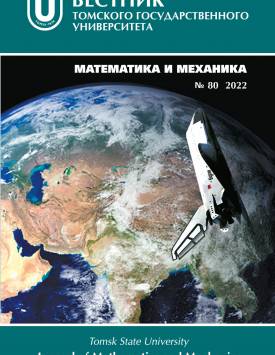Simulation of the interaction of conical impactors having an angle of attack with underwater barriers
In this paper, the effect of the angle of impact and the angle of attack on the interaction between truncated coneshaped impactors made of BHZh-95 alloy and underwater barriers made of aluminum alloy is studied using experimental and computational methods. When such an impactor enters water, a supercavern appears around the impactor and minimizes the fluid friction. During the motion, the impactor afterbody periodically experiences impermanent contact with the walls of the supercavern, which maintains the steady motion. Note that the center of mass of the impactor is located closer to its afterbody, which can induce the angle of attack appearance during the motion. The experimental study is conducted using a hydroballistic track with high-speed video recording. The speed range of 250-350 m/s is considered. Mathematical modeling is carried out using the EFES original software package. It is revealed that a positive angle of attack β ≤ 10° leads to the normalization of the impactor and a decrease in the effective thickness of the barrier with its perforation. In contrast, at a negative angle of attack, the impactor rebounds from the barrier.
Keywords
conical impactor,
high-speed interaction,
model,
deformation,
impact,
rebound,
angle of attackAuthors
| Batuev Stanislav P. | Institute of Strength Physics and Materials Science of the Siberian Branch of the Russian Academy of Sciences | spbatuev@gmail.com |
| D’yachkovskiy Aleksey S. | Tomsk State University | lex_okha@mail.ru |
| Radchenko Pavel A. | Institute of Strength Physics and Materials Science of the Siberian Branch of the Russian Academy of Sciences | pavel@radchenko.site |
| Radchenko Andrey V. | Institute of Strength Physics and Materials Science of the Siberian Branch of the Russian Academy of Sciences | andrey@radchenko.site |
| Sammel’ Anton Yu. | Tomsk State University | anton_sammel@mail.ru |
| Chupashev Andrey V. | Tomsk State University | chupashevav@gmail.com |
Всего: 6
References
Логвинович Г.В. Некоторые вопросы глиссирования и кавитации // Труды ЦАГИ. 1980. Вып. 2052. 271 с.
Савченко Ю.Н., Семененко В.Н., Путилин С.И. Нестационарные процессы при суперкавитационном движении тел // Прикладная гидромеханика. 1999. Т. 73, № 1, С. 79-97.
Федоров С.В., Велданов В.А. К определению размеров кавитационной полости в воде за движущимся с высокой скоростью цилиндрическим телом // Журнал технической физики. 2013. Т. 83, вып. 2. С. 15-20. URL: https://joumals.ioffe.ru/articles/10815
Фомин Н.А. Диагностика быстропротекающих процессов в механике жидкости, газа и плазмы // Инженерно-физический журнал. 2008. Т. 81, № 1. С. 68-80.
Добросельский К.Г. Применение piv метода для исследования течения вблизи поперечно обтекаемого цилиндра // Инженерно-физический журнал. 2016. Т. 89, № 3. С. 687-693.
Логвинович Г.В. Гидродинамика тонкого гибкого тела (оценка гидродинамики рыб) // Ученые записки ЦАГИ. 1970. Т. 1, № 2. С. 11-17.
Афанасьева С.А., Бондарчук И.С., Буркин В.В. Дьячковский А.С., Ищенко А.Н., Рогаев К.С., Саммель А.Ю., Сидоров А.Д., Степанов Е.Ю., Чупашев А.В. Экспериментально-теоретические исследования особенностей высокоскоростного движения в воде суперкавитирующих ударников, изготовленных из разных материалов // Инженерно-физический журнал. 2021. Т. 94, № 6. С. 1528-1537.
Byoung-Kwon Ahn, Tae-Kwon Lee, Hyoung-Tae Kim, Chang-Sup Lee. Experimental investigation of supercavitating flows // Int. J. Nav. Archit. Ocean Eng. 2012. V. 4. P. 123-131.
Седов Л.И. Плоские задачи гидродинамики и аэродинамики. М. -Л. : Гостехиздат, 1951. 444 с.
Савченко Ю.Н. Моделирование суперкавитационных процессов // Прикладна гідромехашка. 2000. № 2 (74). С. 75-86.
Шахтин А.А. Численный метод расчета суперкаверн // Вестник Томского государственного университета. Математика и механика. 2013. № 2 (22). С. 105-109.
Герасимов А.В. Численное моделирование высокоскоростного взаимодействия ударников с преградами конечной толщины: рикошет, внедрение, пробитие // Известия Алтайского государственного университета. 2014. № 1-1 (81). С. 140-143.
Бивин, Ю.К. Проникание, пробивание, рикошет // Актуальные проблемы механики. 50 лет Институту проблем механики им. А.Ю. Ишлинского РАН / Ин-т проблем механики им. А.Ю. Ишлинского РАН. М. : Наука, 2015. С. 406-425.
Государственная регистрация программы для ЭВМ № 2019664836. Трехмерное моделирование деформации и разрушения гетерогенных материалов и конструкций при динамических нагрузках (EFES 2.0) /Радченко П.А., Батуев С.П., Радченко А.В., 2019.
Буркин В.В., Ищенко А.Н., Майстренко И.В., Фуфачев В.М., Дьячковский А.С., Бураков В.А., Корольков Л.В., Степанов Е.Ю., Чупашев А.В.; Рогаев К.С., Саммель А.Ю., Сидоров А.Д. заяв. 09.10.2017; Патент 2683148 РФ. Гидробаллистический стенд, опубл. 26.03.2019.
Radchenko P.A., Radchenko A. V., Batuev S.P. Effect of Projectile Rotation on High-Velocity Impact Fracture // Physical Mesomechanics. 2022. V. 25. P. 119-228. doi: 10.1134/ S1029959922020035

